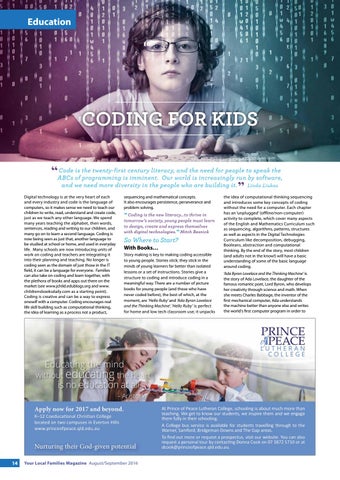Education
CODING FOR KIDS Code is the twenty-first century literacy, and the need for people to speak the ABCs of programming is imminent. Our world is increasingly run by software, Linda Liukas and we need more diversity in the people who are building it. Digital technology is at the very heart of each and every industry and code is the language of computers, so it makes sense we need to teach our children to write, read, understand and create code, just as we teach any other language. We spend many years teaching the alphabet, then words, sentences, reading and writing to our children, and many go on to learn a second language. Coding is now being seen as just that, another language to be studied at school or home, and used in everyday life. Many schools are now introducing units of work on coding and teachers are integrating it into their planning and teaching. No longer is coding seen as the domain of just those in the IT field, it can be a language for everyone. Families can also take on coding and learn together, with the plethora of books and apps out there on the market (see www.jchild.edublogs.org and www. childrensbooksdaily.com as a starting point). Coding is creative and can be a way to express oneself with a computer. Coding encourages real life skill building such as computational thinking, the idea of learning as a process not a product,
14
sequencing and mathematical concepts. It also encourages persistence, perseverance and problem solving.
Coding is the new literacy…to thrive in “tomorrow’s society, young people must learn to design, create and express themselves with digital technologies. Mitch Resnick
”
So Where to Start? With Books…
Story making is key to making coding accessible to young people. Stories stick; they stick in the minds of young learners far better than isolated lessons or a set of instructions. Stories give a structure to coding and introduce coding in a meaningful way. There are a number of picture books for young people (and those who have never coded before), the best of which, at the moment, are ‘Hello Ruby’ and ‘Ada Byron Lovelace and the Thinking Machine’. ‘Hello Ruby’ is perfect for home and low tech classroom use; it unpacks
Your Local Families Magazine August/September 2016
the idea of computational thinking sequencing and introduces some key concepts of coding without the need for a computer. Each chapter has an ‘unplugged’ (offline/non-computer) activity to complete, which cover many aspects of the English and Mathematics Curriculum such as sequencing, algorithms, patterns, structures as well as aspects in the Digital Technologies Curriculum like decomposition, debugging, Booleans, abstraction and computational thinking. By the end of the story, most children (and adults not in the know!) will have a basic understanding of some of the basic language around coding. ‘Ada Byron Lovelace and the Thinking Machine’ is the story of Ada Lovelace, the daughter of the famous romantic poet, Lord Byron, who develops her creativity through science and math. When she meets Charles Babbage, the inventor of the first mechanical computer, Ada understands the machine better than anyone else and writes the world's first computer program in order to
